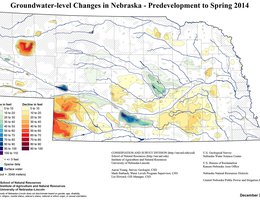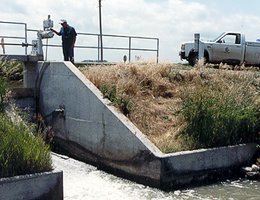
The Central District provides surface water irrigation service to more than 113,000 acres in Phelps, Gosper, Kearney, Lincoln, and Dawson counties. Another 110,000 acres served by several smaller irrigation projects receive supplemental water from Lake McConaughy. In addition, CNPPID’s project provides documented groundwater recharge to more than 310,000 acres in and around its service area, an area with extensive groundwater irrigation development.
The primary water supply for this system originates in the Rocky Mountains of Colorado and Wyoming. Water from the North Platte River flows into Lake McConaughy, mostly as return flows from irrigation projects in eastern Wyoming and western Nebraska. The water stored in Lake McConaughy is released for electrical generation at the Kingsley Hydroplant, for cooling purposes at a coal-burning power plant, and again for hydroelectric generation near North Platte before being diverted into the Central District’s Supply Canal. Once in the Supply Canal, the water is used to generate electricity at three more hydroplants, to cool a power plant that uses natural gas, and for delivery to Central’s three main irrigation canals.

Another important aspect of the Central District’s project is its impact on one of Nebraska’s most valuable resources: the underground aquifer. Recharge from the Tri-County Project’s system maintains groundwater levels in south-central Nebraska. Water that soaks into the ground recharges the underground water supply that is critical to farmers who use wells to irrigate their fields and to towns and cities in the area that pump groundwater to supply homes and businesses. Some of the water also moves underground back to rivers and streams in the area, helping to supplement stream flows.
The Central District undertook two major rehabilitation projects in the 1970s and 1980s on the E65 and Phelps Canals. During the planning stages for these projects, groundwater modeling studies helped engineers determine where it would be best to allow more recharge from the canals to benefit groundwater tables and where it would be best to install pipelines and lined canals to reduce the amount of water entering the groundwater table. The result has been a generally stable water table beneath and adjacent to CNPPID’s service area.
It was the first time in Nebraska’s history that an irrigation system was designed to address the water supply and the needs of both surface and groundwater irrigators. This “conjunctive use” system recognizes the hydrological connection between surface water and groundwater.

The Central District has been involved in water conservation efforts for many years. Demands on Nebraska’s water resources have increased the importance of conservation and wise use of water resources. Central has addressed water conservation with a variety of innovative programs, methods and technology.
Irrigation deliveries are set up on a rotation schedule designed to encourage conservation by irrigators. Irrigation service specialists patrol canals, laterals, and pipelines and work closely with irrigation customers to coordinate water deliveries. CNPPID measures all deliveries, and a computerized water delivery balance is maintained for each account. So, each customer knows down to a tenth of an inch how much water he has used.
Conditions along the canals are monitored and controlled by computers in the Gothenburg Control Center. The automation enables the Central District to rapidly adjust to changing conditions and efficiently move water through the system.
CNPPID implemented an incentive policy in 2001 that encouraged conversions to center pivot irrigation. As of 2015, irrigation customers have installed more than 450 center pivots on the system serving more than 50,000 acres. These pivots take water from canals, rather than from groundwater, thus eliminating the need for and expense of drilling a well. Pivots are one of the most efficient delivery systems available to farmers today and they typically require less water than irrigation with gated pipe or siphon tubes.
Central has also worked with customers to install other water-saving devices and has improved its canal system to reduce water losses as it travels from the diversion dam at North Platte to the farmers’ fields, all with the intent of ensuring a reliable source of water for everyone who relies on Lake McConaughy.